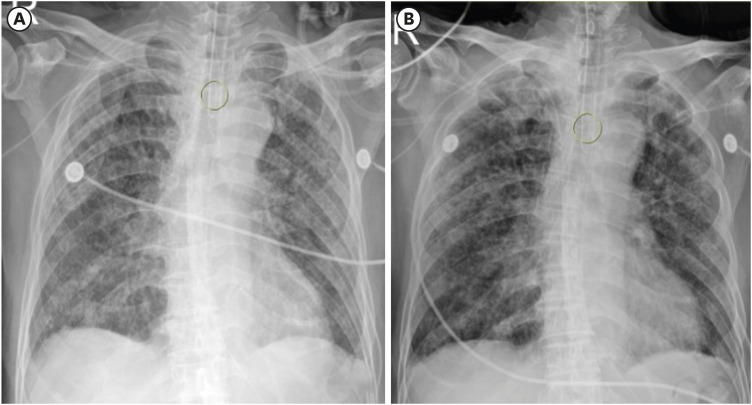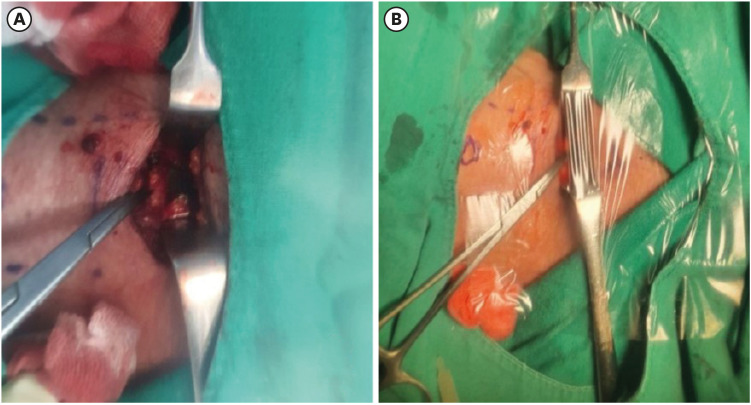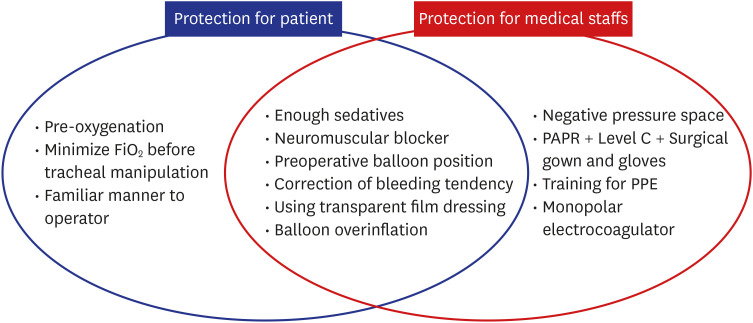J Korean Med Sci.
2020 Jul;35(28):e263. 10.3346/jkms.2020.35.e263.
A Case Report of Tracheostomy for a Patient with COVID-19: How to Minimize Medical Staff and Patient Risks
- Affiliations
-
- 1Department of Surgery, National Medical Center, Seoul, Korea
- KMID: 2504369
- DOI: http://doi.org/10.3346/jkms.2020.35.e263
Abstract
- Coronavirus disease was first reported in December 2019, and the World Health Organization declared it as a pandemic on March 11, 2020. The virus is known to attack various vital organs, including the respiratory system. Patients sometimes require positive pressure ventilation and tracheostomy. Because tracheostomy is a droplet-spreading procedure, medical staff should protect themselves against the risk of transmission of this contagious viral disease. In our case, we performed tracheostomy for a 70-year-old man with coronavirus disease 2019 (COVID-19) who had required more oxygen with gradual weakness of respiratory muscle to maintain his arterial oxygen saturation. We focused on the risks of the medical staffs and patients, and minimized them at the same time using temporary balloon over-inflation, pre-operative adjustment of endotracheal tube position, and attachment of a transparent film dressing to the surgical field without stopping the ventilator while following routine safety measures. Fourteen days after the tracheostomy, all participating medical staff members were healthy and asymptomatic. The patient was discharged 105 days after the COVID-19 diagnosis.
Keyword
Figure
Reference
-
1. Du Toit A. Outbreak of a novel coronavirus. Nat Rev Microbiol. 2020; 18(3):123. PMID: 31988490.
Article2. Phan LT, Nguyen TV, Luong QC, Nguyen TV, Nguyen HT, Le HQ, et al. Importation and human-to-human transmission of a novel coronavirus in Vietnam. N Engl J Med. 2020; 382(9):872–874. PMID: 31991079.
Article3. World Health Organization. Coronavirus disease (COVID-2019) situation reports - 106. Updated 2020. Accessed May 7, 2020. https://www.who.int/docs/default-source/coronaviruse/situation-reports/20200505covid-19-sitrep-106.pdf?sfvrsn=47090f63_2.4. WHO-China Joint Mission. Report of the WHO-China joint mission on coronavirus disease 2019 (COVID-19). Updated 2020. Accessed May 7, 2020. https://www.who.int/docs/default-source/coronaviruse/who-china-joint-mission-on-covid-19-final-report.pdf.5. Wang D, Hu B, Hu C, Zhu F, Liu X, Zhang J, et al. Clinical characteristics of 138 hospitalized patients with 2019 novel coronavirus-infected pneumonia in Wuhan, China. JAMA. 2020; 323(11):1061.
Article6. Takhar A, Walker A, Tricklebank S, Wyncoll D, Hart N, Jacob T, et al. Recommendation of a practical guideline for safe tracheostomy during the COVID-19 pandemic. Eur Arch Otorhinolaryngol. 2020; 277(8):2173–2184. PMID: 32314050.
Article7. Wei WI, Tuen HH, Ng RW, Lam LK. Safe tracheostomy for patients with severe acute respiratory syndrome. Laryngoscope. 2003; 113(10):1777–1779. PMID: 14520105.
Article8. Public Health England. COVID-19: infection prevention and control guidance. Updated 2020. Accessed June 20, 2020. https://assets.publishing.service.gov.uk/government/uploads/system/uploads/attachment_data/file/893320/COVID-19_Infection_prevention_and_control_guidance_complete.pdf.9. Givi B, Schiff BA, Chinn SB, Clayburgh D, Iyer NG, Jalisi S, et al. Safety recommendations for evaluation and surgery of the head and neck during the COVID-19 pandemic. JAMA Otolaryngol Head Neck Surg. 2020; 146(6):579–584.
Article
- Full Text Links
- Actions
-
Cited
- CITED
-
- Close
- Share
- Similar articles
-
- Tracheostomy in the Era of COVID-19 Pandemic
- Characteristics of Hybrid Modified Percutaneous Dilatational Tracheostomy in Patients With COVID-19: A Single Institutional Experience Over 1 Year
- Tracheostomy in COVID-19 Pandemic Era
- Ultrasound-Guided Percutaneous Dilatational Tracheostomy for Critically Ill Patients With COVID-19
- Emergency exploratory laparotomy in a COVID-19 patient - A case report -




